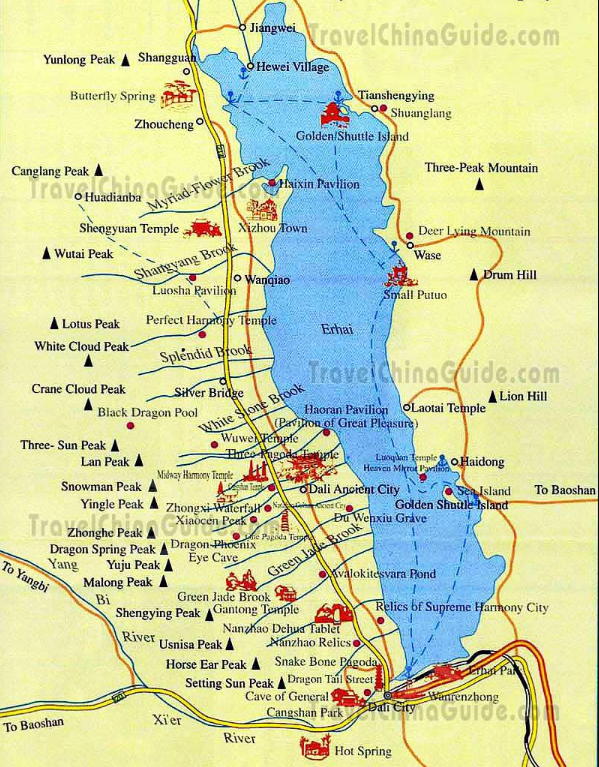

English Name: Dali
Chinese Name: 大理 (dà lǐ)
Population (2021): 3645400
Area: 1815 square kilometers (5.971 square miles)
Location: In the northwest of Yunnan, southwest China
Area Code: 0872
Zip Code: 671000
GDP (2021): ¥51.744 billion ($7.398 billion)
Nationalities: Bai, Han, Yi, Hui
Climate-Type: Low latitude plateau monsoon climate
Geographic Coordinates: 99°58ˊE-100°27ˊE, 25°25ˊN-25°58ˊN
Located northwest of the Yunnan Province, 350 kilometers (217 miles) northwest of Kunming, Dali City is the capital of the Dali Bai Autonomous Prefecture. It once served as the capital of Nanzhao and Dali Kingdom (738 - 1253) and as the political, economic and cultural center of ancient Yunnan for more than 500 years. For many Chinese travelers, Dali is a must-go city on a trip to Yunnan. The luxuriant forests, beautiful Erhai Lake, not to mention its many historic attractions, make it the perfect antidote from the rush and busy life.
![]() Attractions: Dali, a city of great antiquity, beckons the visitor in any season and is always a tempting destination for those interested in exploring fascinating natural scenery and the area's considerable historical and cultural heritage. It is renowned as a land of wonders, both natural and manmade, inspiring in visitors a great appetite for its beauty. Ancient buildings, city walls and the old city moat are the sites most frequented by visitors. Cangshan Mountain and Erhai Lake are praised as the city's leading scenic areas. Most attractions lie between these two landmarks, such as the Butterfly Spring, and the Three Pagodas of Chongsheng Temple.
Attractions: Dali, a city of great antiquity, beckons the visitor in any season and is always a tempting destination for those interested in exploring fascinating natural scenery and the area's considerable historical and cultural heritage. It is renowned as a land of wonders, both natural and manmade, inspiring in visitors a great appetite for its beauty. Ancient buildings, city walls and the old city moat are the sites most frequented by visitors. Cangshan Mountain and Erhai Lake are praised as the city's leading scenic areas. Most attractions lie between these two landmarks, such as the Butterfly Spring, and the Three Pagodas of Chongsheng Temple.
![]() Transportation: Nowadays, Dali has been linked with many nearby and major cities in China by flight, train and long-distance bus. Even though, the most popular way to get there is from Kunming by direct train or bus. If time permits, one may tour Kunming before going on the trip to Dali. The transportation inside Dali also brings a lot of convenience to tourists, including frequent city buses, ships, taxis and bicycles.
Transportation: Nowadays, Dali has been linked with many nearby and major cities in China by flight, train and long-distance bus. Even though, the most popular way to get there is from Kunming by direct train or bus. If time permits, one may tour Kunming before going on the trip to Dali. The transportation inside Dali also brings a lot of convenience to tourists, including frequent city buses, ships, taxis and bicycles.
![]() Weather: Without a clear distinction between the four seasons, Dali weather varies but with an annual mean temperature ranging from 12°C (54°F) to 19°C (66°F) there are no extremes.
Weather: Without a clear distinction between the four seasons, Dali weather varies but with an annual mean temperature ranging from 12°C (54°F) to 19°C (66°F) there are no extremes.
![]() History: As early as 4,000 years ago, the ancestors of the Bai people settled in this area. In the Second Century AD, it was brought into the territory of the central government of Han Dynasty (206 BC-220AD). Two ethnic states, the Nanzhao State (738-937) in Tang Dynasty (618-907), and the Dali State (937-1253) in Song Dynasty (960-1279), were once established here as well. Throughout ages, it remained an intermediary area linking economic and cultural communications between ancient China and other countries via India. The remains of the Tai He City and the Dali Ancient City bear witness to thousands of years of historic changes once happened here. Together with the Xizhou Town and the Zhoucheng Village, the ancient towns around show the best of historic customs of daily life within the Bai Minority.
History: As early as 4,000 years ago, the ancestors of the Bai people settled in this area. In the Second Century AD, it was brought into the territory of the central government of Han Dynasty (206 BC-220AD). Two ethnic states, the Nanzhao State (738-937) in Tang Dynasty (618-907), and the Dali State (937-1253) in Song Dynasty (960-1279), were once established here as well. Throughout ages, it remained an intermediary area linking economic and cultural communications between ancient China and other countries via India. The remains of the Tai He City and the Dali Ancient City bear witness to thousands of years of historic changes once happened here. Together with the Xizhou Town and the Zhoucheng Village, the ancient towns around show the best of historic customs of daily life within the Bai Minority.![]() Local Highlights: Ethnic minorities have inhabited in this area for generations, with the Bai Minority making up the majority of its population (65%). The customs of the ethnic minorities bring charm to daily life. Each spring, celebrations and festivals bring the city to life. Celebrations such as the March Street Festival and Butterfly Fest provide excellent opportunities to learn about local folk customs.
Local Highlights: Ethnic minorities have inhabited in this area for generations, with the Bai Minority making up the majority of its population (65%). The customs of the ethnic minorities bring charm to daily life. Each spring, celebrations and festivals bring the city to life. Celebrations such as the March Street Festival and Butterfly Fest provide excellent opportunities to learn about local folk customs.![]() Special Local Products: The famous Foreigner Street in the Ancient City attracts visitors with its handicrafts, and local culinary delicacies. Xiaguan, located to the south of the Ancient City, home to the government of the Dali Bai Autonomous Prefecture. Here hotels, public squares, and shopping centers add modernity to the otherwise historical city.
Special Local Products: The famous Foreigner Street in the Ancient City attracts visitors with its handicrafts, and local culinary delicacies. Xiaguan, located to the south of the Ancient City, home to the government of the Dali Bai Autonomous Prefecture. Here hotels, public squares, and shopping centers add modernity to the otherwise historical city.
![]() Dining: Dali is perhaps most well-known for dishes historically cooked by the Bai, one of its ethnic minority groups, and should certainly not be missed by those stopping in the area. However, the city is a melting-pot for many different cultures, and offers visitors the chance to sample numerous foods from around Yunnan Province and other Chinese delicacies.
Dining: Dali is perhaps most well-known for dishes historically cooked by the Bai, one of its ethnic minority groups, and should certainly not be missed by those stopping in the area. However, the city is a melting-pot for many different cultures, and offers visitors the chance to sample numerous foods from around Yunnan Province and other Chinese delicacies.
![]() Shopping: The ideal location for shopping in Dali must be Foreigner Street in the Ancient City of Dali. This street exhibits an abundance of localspecialties. In the dwelling area of the Bai minority group, characteristic handicraft articles of the Bai people can be purchased. Furthermore, supermarkets and shopping malls can also meet visitors' daily necessities.
Shopping: The ideal location for shopping in Dali must be Foreigner Street in the Ancient City of Dali. This street exhibits an abundance of localspecialties. In the dwelling area of the Bai minority group, characteristic handicraft articles of the Bai people can be purchased. Furthermore, supermarkets and shopping malls can also meet visitors' daily necessities.
![]() Top 10 Things to Do in Dali: Dali in southwest China is known for appealing natural landscapes and diverse culture of ethnic minorities, rewarding its visitors lots of interesting things to do in Dali, like climbing Cangshan Mountain, cycling around Erhai Lake, seeing traditional residences, watching Bai people’s music and dance performance, try tie-dying, and taste delicious local food.
Top 10 Things to Do in Dali: Dali in southwest China is known for appealing natural landscapes and diverse culture of ethnic minorities, rewarding its visitors lots of interesting things to do in Dali, like climbing Cangshan Mountain, cycling around Erhai Lake, seeing traditional residences, watching Bai people’s music and dance performance, try tie-dying, and taste delicious local food.